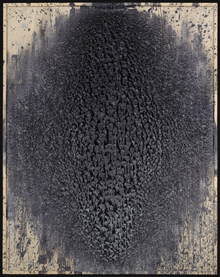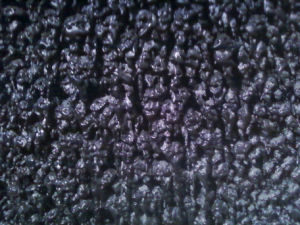Slow Art Day has asked its 2013 college interns to write short summaries of their own experiences looking slowly at artworks of their choosing.
Out of the corner of my eye, I can feel Dorian Gray digging into the back of my neck, his carbonized tendrils reaching outward with a foreboding aura.
Martin Kline’s Dorian Gray (2011) is currently situated on the fourth floor of the Sackler Museum (one of the Harvard Art Museums). The encaustic on panel work resides in a tucked-away enclave to the left, and I might have passed it by, if not for the incredible breathtaking presence of the piece quickly enveloping me. The odd fact that this very contemporary work is being displayed on a floor usually reserved for historical European works from Middle Ages to Modern Art is jarring. And yet, it seems completely appropriate. Its uniqueness demands its own votive-like shrine. It shouts loudly for your attention in order to simmer to a boil before your stolen attention.
This ‘portrait’ does not portray the Oscar Wilde character in his eternal youth. Instead, the spellbinding work showcases the blistering and decaying remains of the bewitched painting. Miraculously the work still carries the same devilish, enigmatic force that you would expect from a depiction of Dorian’s debaucherous descent in his perpetual youth.
As I gaze at Kline’s work, however, I temporarily forget all literary references. Regardless of intent or allusion, this piece literally feels timeless. From all directions and perspectives it becomes reminiscent of so many worldly forms. I feel as if I need to mentally map the pulsating topography of the piece inch by inch. A gigantic festering blister at direct view morphs slowly into a singed old growth forest to bubbling, oozing lava, to a hearty crop of stalagmites as my gaze traverses the panel. I am able to visually trace the peaks and valleys, following them down into the crevasses created by the dripped wax terrain. The technique used by Kline, curiously one of addition and growth instead of the destruction that you would assume of the corrupted portrait, adds to the oddly lively artwork.
I realize something while looking horizontally from the right at the Martian landscape (after exhausting all of my other viewing options, museum etiquette-wise). Stepping back a few feet, I see that the wax used is a variety of colors, not the monotone mound it appears to be. Light gray, dark gray, even a sickly shade of green is intermixed to add depth and shading to the work. I was so close and drawn into the work that I didn’t realize this core component. What else did I miss?
I draw back, not in retreat, but in pursuit. The optical feat created both by the layers of wax and its pigmentation is still enchanting and intoxicating. As I’m across the gallery, however, I realize that I’ve made a crucial mistake in my original viewing of the work. This is not a remnant of past events, or a passively brewing force.
This work has a life of its own and it’s still spreading.
-Karen Trop, Bennington College.
Martin Kline’s Dorian Gray among other great works is available to view at the Arthur M. Sackler Museum in Cambridge, MA. The Harvard Art Museums are not currently hosting a Slow Art Day event. Inspired? Sign up as a host today!



I have to se this for myself now!!
This is such a great write-up Karen! You really captured the layers of meaning in this piece.
Wow! I suddenly have an urge to take the next flight to Boston, grab a taxi and see this piece of art for myself.